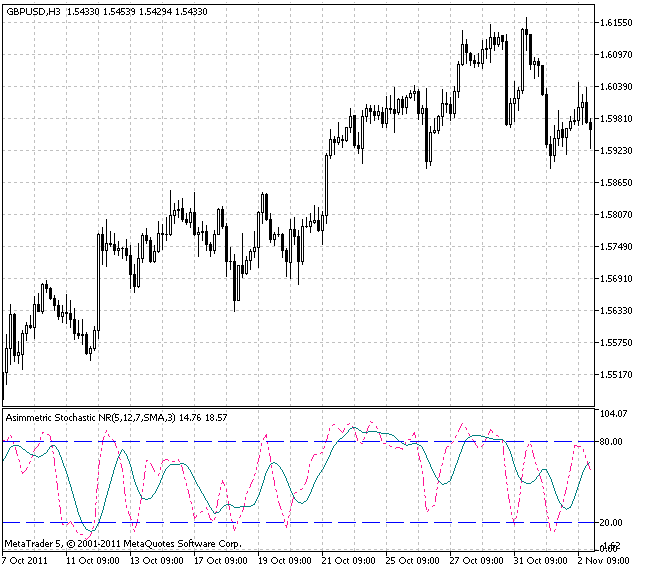Join our fan page
- Published by:
- Nikolay Kositsin
- Views:
- 7894
- Rating:
- Published:
- Updated:
-
Need a robot or indicator based on this code? Order it on Freelance Go to Freelance
Real author:
Svinozavr
Enhanced version of the Stochastic Oscillator. As for parameter fields, asymmetric Stochastic has only three differences from the standard one:
Kperiod now consists of two values - junior KperiodShort (short) and senior KperiodLong (long).
Oversold (OS) and overbought (OB) levels parameters are added. In case Stochastic enters OS/OB areas, Kperiods (lengths of highs/lows searching) are switched over.
The third difference (sensitivity limit) is a Sens parameter, which allows to cut off scillations below a certain limit set in points. Thereby, the number of false signals is considerably reduced. The fact is that the standard Stochastic locates the current price between price highs and lows for the number of bars set by %K (Kperiod) parameter. And it does not matter, if extreme points differ from each other by 1 or 100 points. It will still indicate that OS/OB values are reached. Implementation of some limit allows to cut off oscillations that are inconsiderable for a trading system.
Behavior:
In case Stochastic enters OS area, the indicator searches for lows at the bars junior Kperiod (KperiodShort) and for highs - at the senior (KperiodLong) one. In case Stochastic enters OB area, lows are searched for at the long interval, while highs - at the short one.
Interpretation/usage. Entering OS/OB by Stochastic means switching a trend over to the appropriate direction. However, trend switching generally does NOT mean a signal for market entry according to the current trend direction. Position should be opened during a correction, which can be identified by 50% line crossing/touching. If you follow the "turtle" strategy, additions to your position should be made during corrections. When a trend is being switched over, positions should be closed completely or decreased. In the latter case complete closing of a position is carried out during the correction, while a new position in the opposite direction is opened simultaneously. Stop levels are set near the previous (opposite) extreme point with a reasonable setback. But their triggering in the operating mode is unlikely. Stop levels are set there only for force majeure conditions.
This indicator was first implemented in MQL4 and published in Code Base 22.04.2010.
Indicator input parameters:
//+-----------------------------------+ //| Indicator input parameters | //+-----------------------------------+ input uint KperiodShort=5; // %K period input uint KperiodLong=12; // %K period input Smooth_Method DMethod=MODE_SMA; // Signal line smoothing method input uint Dperiod=7; // %D signal line period input int DPhase=15; // Signal line smoothing parameter input uint Slowing=3; // Slowing input ENUM_STO_PRICE PriceField=STO_LOWHIGH; // Prices selection parameter for calculation input uint Sens=7; // Sensitivity in points input uint OverBought=80; // Overbought level, %% input uint OverSold=20; // Oversold level, %% input color LevelsColor=Blue; // Levels color input STYLE Levelstyle=DASH_; // Levels style input WIDTH LevelsWidth=Width_1; // Levels width input int Shift=0; // Horizontal shift of the indicator in bars
This indicator allows to select a smoothing type of the signal line out of ten possible versions:
- SMA - simple moving average;
- EMA - exponential moving average;
- SMMA - smoothed moving average;
- LWMA - linear weighted moving average;
- JJMA - JMA adaptive average;
- JurX - ultralinear smoothing;
- ParMA - parabolic smoothing;
- T3 - Tillson's multiple exponential smoothing;
- VIDYA - smoothing with the use of Tushar Chande's algorithm;
- AMA - smoothing with the use of Perry Kaufman's algorithm.
It should be noted that Phase type parameters for different smoothing algorithms have completely different meaning. For JMA it is an external Phase variable changing from -100 to +100. For T3 it is a smoothing ratio multiplied by 100 for better visualization, for VIDYA it is a CMO oscillator period and for AMA it is a slow EMA period. In other algorithms these parameters do not affect smoothing. For AMA fast EMA period is a fixed value and is equal to 2 by default. The ratio of raising to the power is also equal to 2 for AMA.
The indicator uses SmoothAlgorithms.mqh library classes (must be copied to the terminal_data_folder\MQL5\Include). The use of the classes was thoroughly described in the article "Averaging Price Series for Intermediate Calculations Without Using Additional Buffers".

Translated from Russian by MetaQuotes Ltd.
Original code: https://www.mql5.com/ru/code/714
 RBVI
RBVI
The basis of the RBVI Forex indicator is an attribute of the night market to sharply decrease the volatility due to absence of active trading on exchanges. The indicator considers the price flow and the volatility (changeability) of the market what helps to successfully behave in a flat market. It is recommended to use RBVI in Expert Advisors that run in night time.
 SVS_Trend
SVS_Trend
Trend Indicator. There are 10 possible variants of changing the averaging of the signal line in this indicator.
 RSI_AC_Stochastic_Signal
RSI_AC_Stochastic_Signal
This indicator shows trend direction (RSI) and trading signals (Stochastic + Accelerator).
 ZigZag_INT
ZigZag_INT
ZigZag indicator version with optimized calculation speed.